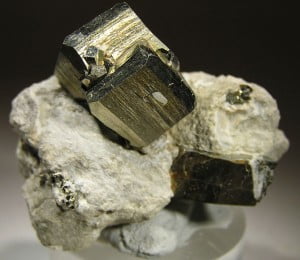New research done at the Weizmann Institute, in collaboration with the University of Wisconsin and California Institute of Technology, suggests that sulfur plays a large role in regulating atmospheric oxygen levels.
As sulfur cycles through the earth’s atmosphere, oceans and land, it undergoes chemical changes that are often coupled with changes in other elements, such as oxygen. Although this affects concentrations of free oxygen, sulfur has traditionally been portrayed as secondary to carbon in the regulation of atmospheric oxygen.
Related Story:
Study: Geological Clock Ticks Faster Than We Thought
The new study shows that in fact the sulfur cycle, in particular the formation of pyrite, or “fool’s gold” as it is commonly known (because some people are fooled by its similarity to gold), is an important contributor of oxygen to the Earth’s atmosphere.
Cycling millions of years
The researchers were trying to better understand the global sulfur cycle over the last 550 million years. Using a database with detailed information on thousands of rock units across the world they traced the formation of sulfur-bearing minerals called sulfate evaporite minerals. These settle to the bottom of shallow seas as seawater evaporates and are buried in the underlying sediments. They were thought to be the main way sulfur exited ocean water as part of the geochemical cycle.
Oxygen has been present at its current atmospheric level of about 20 percent for roughly the last 550 million years. While studying the process the team was surprised to find that while oxygen levels remained quite constant, the formation and burial of sulfate evaporites was highly variable. Even more surprising was the discovery that only a relatively small fraction of sulfur cycling through oceans exited this way. Their research showed that it was in fact another sulfur-bearing mineral, pyrite, which presented a much more important sulfur exit.
Pyrite is an iron-sulfur mineral. It forms in seafloor sediments when microbes use sulfur dissolved in seawater to digest organic matter. The microbes take up sulfur in the form of sulfate – sulfur bound to four oxygen atoms – and release it as sulfide – that has no oxygen. The oxygen released in this process is then freed into the ocean and air.
Sign up for our free weekly newsletter
SubscribeThis part of the sulfur cycle was always thought to be minor in comparison to sulfate evaporate burial, which does not release oxygen, and so its effects were deemed unimportant to oxygen release. Prior estimates indicated that the production and burial of pyrite accounted for about 30 to 40 percent of all sulfur removal from the ocean, but Dr. Itay Halevy and his team found that it actually accounts for more than 80 percent.
Sulfur and what we breathe
This means that the sulfur cycle plays an important role in regulating the atmospheric concentrations of oxygen. The discovery was supported by the fact that during the same period that oxygen levels were stable so was pyrite burial. The analysis also revealed that most of the sulfur entering the ocean washed in from the weathering of pyrite exposed on land. In other words, there is a balance between pyrite formation and burial, which releases oxygen, and the weathering of pyrite on land, which collects it.
“For me, the truly surprising result is that pyrite weathering and burial appear to be such important processes in the sulfur cycle throughout all of Earth’s history. The carbon cycle is recognized as the central hub controlling redox processes on Earth, but our work suggests that nearly as many electrons are shuttled through the sulfur cycle,” said Woodward Fischer, one of the scientists involved.
“These findings, in addition to shedding new light on the role of sulfur in regulating oxygen levels in the atmosphere, represent an important step forward in developing a quantitative, mechanistic understanding of the processes governing the global sulfur cycle,” explained Halevy.
The research was done by Drs. Itay Halevy of the Weizmann Institue’s Environmental Science and Energy Research Department, Shanan Peters of the University of Wisconsin, and Woodward Fischer of the California Institute of Technology. It was published in Science magazine. The database, called Macrostrat, was developed by Peters at the University of Wisconsin.
Photo by pnjunction2007
Related posts

Resilient And Nutritious New Plant-Based Milk Aims To Make A Splash

Chocolate From Cultivated Cocoa Comes Without Environmental Toll

Plastic Fantastic: Startup Takes PVC Back To Its Crude Oil Roots





Facebook comments